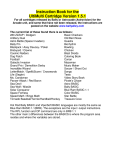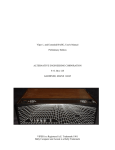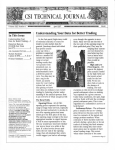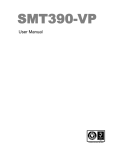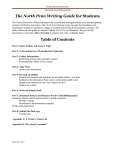Download Blue Ram Owner`s Manual
Transcript
Blue Ram Owner's Manual Perkins Engineering 1004 Pleasant Avenue Boyne City, MI 49712 Copyright 1982 Blue Ram Owner's Manual Version 1.1 - Released Oct 15, 2000 This document has been retyped and converted to PDF format courtesy of the Bally Alley newsletter. For other reprints and more information visit: http://www.ballyalley.com Corrections? Suggestions? Email Adam Trionfo at: [email protected] Blue Ram Operations. General. The Blue Ram contains the following features: 1. 16384 (16K) bytes of read-write random access memory (RAM) which can be write protected either manually or under Program control. This memory is in addition to the 4096 (4K) bytes of screen RAM built into the Arcade. The memory expansion option adds another 16384 bytes for a total of 32768 (32K) bytes of RAM. This memory is located at %(245765) or 6000 (hex). Note that ASTROBASIC treats negative memory addresses as references to screen memory making it impossible to access more than the first 8K of Blue Ram memory using that cartridge. Use Blue Ram BASIC for full memory access. 2. 128 bytes of additional scratch pad memory which cannot be protected from write operations,. This memory is located at %(-24576) or A000 (hex) in a 16K Blue Ram and at %(-8192) or E000 (hex) in a 32K Blue Ram. Note that ASTROBASIC treats negative memory addresses as references to screen memory making it impossible to access this Blue Ram memory area using that cartridge. Use Blue Ram BASIC for full memory access. 3. A RANGE switch to allocate the first 8192 (8k) bytes of RAM to either 6000 (hex) for normal use or 2000 (hex) for game cartridge emulation. In the latter position the RAM acts as if it were a cartridge plugged into the front of the Arcade and running a machine-code Program. 4. Two eight-line bi-directional I/O Ports (PORT A and PORT B) where any line or combination of lines may be in either port may be assigned as input or output lines under Program control. I/O lines may be reconfigured at will under program control, by operating several control resisters within the Blue Ram. 5. External Power and ground (+5v and 0v) available for powering additional low power (<0.5A) applications. The internal power supply has thermal protection against overloads which results in the temporary loss of power should an overload exist. 6. Special Ports available for AUDIO-MIX, CPU CLOCK, I/O OPERATION SYNC, and I/O WAIT SYNC for expansion to (future) devices such as floppy disks and voice synthesis. 7. All external connections to the Blue Ram are made via a 24 Pin zero-insertion-force (ZIF) socket for easy access. This type of socket can accommodate 24 Pin Plugs, component leads, and bare wire ends directly without risk of bending. 8. 2 2000 BAUD tape ports for use with Blue Ram BASIC. One Port (MIC) is used for saving programs and data using Blue Ram BASIC. The other Port (EAR) is used to reload programs and data saved using Blue Ram BASIC. These Ports operate only in conjunction with Blue Ram BASIC. Use the tape interface jack (on the cartridge or tape interface) when operating with ASTROSASIC or BALLY BASIC. Blue Ram User's Manual - Page 1 of 8 Installation Procedure. 1. Locate the long rectangular "knock-out" on the back center of the Arcade case. Using a small screwdriver or knife, carefully remove this knock-out ensuring that you do not poke the screwdriver or knife into the case more than 1/4 inch. 2. The 50 Pin PC connector exposed in the previous step may have its access blocked or interfered with by a portion of the insulating "fish paper" just below the circuit board. If this is the case, the portion which blocks access to the full depth of the connector must be removed. The easiest method of accomplishing this task is to use a very sharp Exacto knife to cut parts in the fish paper at the edge of the access hole, and bend it out of the way. Be sure to cut downward (away from the PC board) to prevent damage to the circuitry. An alternate method involves removing the upper case part, loosening the board, and cutting the fish paper with scissors. 3. Push the Blue Ram 50-pin edge connector all the way onto the PC board connector until a firm stop is felt. Connect the small plug on the power module cord into the small (front) jack on the Blue Ram and plug the power module itself into a suitable 120v receptacle. Turn on the Arcade and depress RESET. This completes the installation procedure. 4. If you are using Blue Ram (super extended) BASIC 1.1 in conjunction with the Blue Ram, ensure that all switches on the Blue Ram are in their back-part (6K RAM AUTO LOAD) position, insert Blue Ram (super extended) BASIC 1.1 into the cartridge slot, and depress RESET again. "Blue Ram BASIC 1.1" should be displayed at the top of the screen in dark blue on a light blue background, this verifies proper installation. 5. The Blue Ram contains non-volatile (static) memory and the contents may be preserved by leaving it plugged in. It will draw less than 5 watts of power when not in use and may be left in this "standby" condition, even with the Arcade turned off. Warning! Ensure that the power module cord plug remains plugged fully into the Blue Ram! Failure of the power module may occur if that plug slips part way out of the jack! Caution! Do not remove the Blue Ram from the Arcade by pulling on the cable! Apply removal pressure directly to the edge connector either by prying from the sides with a small screwdriver or by removing the Arcade case and pushing directly on the edge connector. Blue Ram User's Manual - Page 2 of 8 Switch Settings. There are three switches on the Blue Ram for control of memory range, memory write Protection, and the 2000 BAUD tape interface. 1. Range Switch: The RANGE switch is used to allocate Blue Ram memory to a particular starting location or address and has two positions. The 6K-RAM position is the normal position for this switch and allocates the starting address of Blue Ram memory to 24576 (or 6000 hex ). For example, PRINT %(24576) prints the contents of the first word of Blue Ram memory. (Note that the line number of the first line of a Blue Ram BASIC program normally occupies this word.) The 2K-CASS position of the RANGE switch allocates the first 8K of memory so that it displaces the cartridge (if any) which is plugged into the cassette slot on the front of the Arcade. The only use of this Position is to emulate a game cartridge by running a machine-code program similar to those in the regular game cartridges. Future issues of the Arcadian will explore this feature further. Also, see the Customize A Game Cartridge feature of the Blue Ram Utility. 2. Mode Switch: The mode switch is used to control memory protection and has three positions. The AUTO position is the normal position for this switch and allows memory protection to be controlled by a program. (See &(64) and &(192) in the INPUT/OUTPUT section). The RAM (center) position disables memory write protection even if it was enabled by a program. Similarly, the ROM position prevents all writes to memory, except scratch-pad memory, regardless of any program instructions to the contrary. 3. Tape Switch: The TAPE switch controls the 2000 BAUD tape interface and has two positions. The LOAD position is the normal position of this switch and allows 2000 BAUD programs previously saved using Blue Ram BASIC to be loaded back into the Blue Ram using the same Blue Ram BASIC. With the TAPE switch in this Position, line 0 of PORT B is internally connected to the tape interface and may not be used for other devices. However, with the TAPE switch in this Position, 2000 BAUD tapes May be duplicated by playing the master tape from one recorder using the EAR connection, while recording the duplicate on another recorder using the MIC connection. The 2000 BAUD interface will control the record level and the wave shape of the duplicate, offering enhanced data fidelity in many cases. The SAVE position is used in conjunction with Blue Ram BASIC to save programs and data on tape at 2000 BAUD. This switch position is also used when it is necessary to use line 0 of PORT B for other than tape input. The TAPE indicator light is permanently connected to line 0 of PORT B and may thus be lit under program control. For example, &(163)=1;&(152)=0 will light the TAPE light when the TAPE switch is in the SAVE position. Blue Ram User's Manual - Page 3 of 8 RANGE TAPE SWITCH SWITCH ZIF SOCKET | | | | MODE | | | SWITCH | | | | | +----------|---------------|----|----|----+ | | | | | |] | +------|--------+ | | | |] ---EAR JACK | | [[[[[[[[[[[[ |=() | | | |] | | | (0) (0) (0) | | | [[[[[[[[[[[[ | |] | +---------------+ |] ---MIC JACK | (0) |] | B L U E R A M | | | | |] ---POWER JACK | | |] | | | +------------------------------------|----+ | | TAPE INDICATOR Decimal address 24576 32767 -32768 -24577 -24576 -24449 -8193 -8192 -8065 +--------------------------+ | | | LOWER 8K | | | +--------------------------+ | | | SECOND 8K | | | +--------------------------+ | SCRATCH-PAD FOR 16k SIZE | +--------------------------+ | | | | | SECOND 16k | | | | | | | +--------------------------+ | SCRATCH-PAD FOR 32K SIZE | +--------------------------+ 6000 7FFF 8000 9FFF A000 A07F DFFF E000 E07F Blue Ram User's Manual - Page 4 of 8 - highest address which can be accessed by ASTROBASIC or BALLY BASIC Using the Blue Ram with ASTROBASIC or BALLY BASIC Extended strings. Of the many ways to use the Blue Ram in conjunction with ASTROBASIC or BALLY BASIC, probably the easiest is in the form of extended strings. As you are aware, either of these BASICs will access up to.900 string entries (with no program) using the @(n) symbol. If you write a 1000 byte program (SZ=800) then on 400 string entries are available. However, with the Blue Ram 8256 string entries (16448 for 32K option) are always available, regardless of the size of your BASIC Program. What's more, these string entries do not "move around" or otherwise change when you modify your BASIC program or load another program. This makes these special Blue Ram string entries valuable for passing large quantities of data between programs. The Blue Ram extended string entries are accessed using the %(2n+24576) form to "poke" and "peek" values into the extended strings. String entry #0 therefore, is at %(24576) (since 2x0+24576=24576), string entry #1 is at %(24578), #2 is at %(24580), etc. The MODE switch should be in either the RAM or AUTO position with RAM enabled. Performing a &(192)=0 will enable RAM mode in the AUTO Position. Try this short example: 10 20 30 40 50 60 FOR N=1 TO 25 %(2xN+24576)=N NEXT N FOR M=1 TO 25 PRINT %(2Xm+24576) NEXT M 25 count loop stores string number in string completes loop another 25 count loop prints string content completes loop You will note that each of the first 25 string entries were set to their own string number. Note also that the 2x term provides 2 bytes (one word) for each string entry. A more efficient way of writing the same program is: 10 N=1;FOR A=24578 TO 24626 STEP 2;%(A)=N;N=N+1;NEXT A 20 FOR M=24578 TO 24626 STEP 2;PRINT %(M);NEXT M A Program will always be more efficient if the Programmer does the math (2x1+24576=24578 and 2x25+24576=24626) and uses the results as the values in the program statements so that the computer does not have to calculate those values over and over again when the program is running. Blue Ram User's Manual - Page 5 of 8 INPUT/OUTPUT. The Blue Ram contains two 8-line bi-directional I/O ports. The first 8 lines are referred to as port A while the second 8 lines are referred to as port B. Either port may be configured with any line or combination of lines being in the INPUT mode (for receiving signals) or the OUTPUT mode (for sending signals). The following diagram shows the location of each line of each port on the 24 Pin ZIF socket: 12 11 10 9 8 7 6 5 4 3 2 1 +---------------------------------------+ | A C + 0 1 2 3 4 5 6 7 G | |==( ) | U L 5 N --| | D K v ---- PORT A LINES ---- D | | | | | | G ---- PORT B LINES ---- + - | | N 5 W I | | D 7 6 5 4 3 2 1 0 v T O | +---------------------------------------+ 13 14 15 16 17 18 19 20 21 22 23 24 PIN --1 2 3 4 5 6 7 8 9 10 11 12 FUNCTION -------Ground return for PORT A Line 7 of PORT A Line 6 of PORT A Line 5 of PORT A Line 4 of PORT A Line 3 of PORT A Line 2 of PORT A Line 1 of PORT A Line 0 of PORT A +5v source for PORT A Z80 CLOCK for external sync AUDIO-MIX to add or tap sound PIN --13 14 15 16 17 18 19 20 21 22 23 24 FUNCTION -------Ground return for PORT B Line 7 of PORT B Line 6 of PORT B Line 5 of PORT B Line 4 of PORT B Line 3 of PORT B Line 2 of PORT B Line 1 of PORT B Line 0 of PORT B * +5v source for PORT B WAIT(N) for external sync IOREQ(N) for external sync *Also connected to 2000 BAUD tape interface monitor light and is held at Ov when the TAPE switch is in the LOAD position. Place the TAPE switch in the SAVE position to use the line (with indicator) for other purposes. The audio mixer (AUD) port accepts and/or provides a 1000-ohm +/- 2v audio signal to be mixed with or extracted from the Arcade sound system. This port may be used to extract sound from the Arcade to feed into a high fidelity amplifier or to add sound such as a tape recorder voice-track or a voice synthesizer. The CLK, -WT, and -IO signals are connected directly to the Z80 microprocessor (pins 6, 24, and 20 respectively) and will be used for circuit synchronization in future Blue Ram add-ons such as disk drives, etc. Blue Ram User's Manual - Page 6 of 8 Program control of the I/O ports is accomplished in BASIC via the &(n) term where n is an I/O port number from the following table: Read x=&(n) Write &(n)=x 162 Function Configures PORT A lines to be INPUT lines or OUTPUT lines accordion to the value written to &(162). Each line is an INPUT line unless it is programmed as an OUTPUT line by setting its corresponding bit value into &(162): line 0 = line 3 = line 6 = 163 160 160 161 161 128 128 129 through 135 136 through 143 144 129 through 135 136 through 143 144 145 through 151 145 through 151 1 8 64 line 1 = 2 line 4 = 16 line 7 = 128 line 2 = line 5 = 4 32 Example: To allocate PORT A lines 0, 1, 5, and 7 as OUTPUT lines - &(162)=1+2+32+128 or &(162)=163 Configures PORT B lines to be INPUT lines or OUTPUT lines according to the value written to &(163) as with &(162) above. Accesses PORT A for data transfers to and from devices connected to PORT A. INPUT lines held high (>0,6v) during a read operation result in their corresponding bit value being read from &(160). A write operation to 60 causes the corresponding OUTPUT lines to be set as indicated by the value written to &(160). Example: To set all even OUTPUT lines of PORT A high (>3.2v) -&(160)=1+4+16+64 or &(160)=85. To verify this -- PRINT &(160) NOTE: Outputs may read back as inputs. Accesses PORT B for data transfers to and from devices connected to PORT B as with &(160) above. Accesses line 0 of PORT A individually. If line 0 is held high during a read operation, a value of 128 is read; otherwise the value is 0. If line 0 of PORT A is allocated as an OUTPUT line, any value written to &(128) will cause line 0 of PORT A to be reset low (<0.6v) without affecting any other line. Same as &(128) except that it applies to lines 1 through 7 of PORT A respectively. Same as &(128) except that it applies to lines 0 through 7 of PORT B respectively. Same as &(128) except that any value written to &(144) will cause line 0 of PORT A to be set high (>3.2v) without affecting any other line. Same as &(144) except that it applies to lines 1 through 7 of PORT A respectively. Blue Ram User's Manual - Page 7 of 8 Read x=&(n) 152 through 159 Write &(n)=x 152 through 159 164 64 64 192 192 Note: Function Same as &(144) except that it applies to lines 0 through 7 of PORT B respectively. A write operation to &(164) sets the overall operating mode of the I/O lines of PORT A and PORT B. Writing a value of 0 allows independent operation of all lines of both ports. This is the normal mode placed in effect by a RESET switch depression on the Arcade. &(164)=32 causes the strobed input mode to be activated whereby PORT A input data is latched as line 7 of PORT B goes low. Line 6 of PORT B (OUTPUT) is brought low until the program reads PORT A, indicating that the INPUT data is being held in the Blue Ram. &(164)=96 causes the strobed output mode to be activated whereby line 6 of PORT B (OUTPUT) is brought low to indicate new data has been written to PORT A and is waiting for the device to accept it. The device brings line 7 of PORT B low to indicate that it has accepted the PORT A OUTPUT data and that the next output may now be written to PORT A. &(164)=224 causes a mode to be activated which is similar to &(164)=96 except that the OUTPUT data on PORT A lines only appears while line 7 of PORT B is held low by the external device. &(164)=0 resets the mode to independent operation of all port lines. Any operation with &(64) sets the memory mode to ROM when the MODE switch is in the AUTO position Any operation with &(192) sets the memory mode to RAM when the MODE switch is in the AUTO position. Output lines will only supply 2ma. of current. Do not expect them to drive heavy loads. Use small relays or other amplifiers where more power is required. Warning! Warning! Warning! Warning! Warning! Warning! Warning! Warning! Warning! Do not connect A.C. appliances directly to the Blue Ram I/O ports! Never connect power from a 120v socket directly to any part of your Arcade or the Blue Ram or severe damage and shock hazard will result!!! Relays or optical isolators with at least 1500v isolation should be used for controlling 120v A.C. appliances. Blue Ram User's Manual - Page 8 of 8










